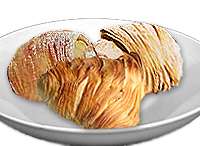Sfogliatella
A sfogliatella (Italian pronunciation: [sfoʎʎaˈtɛlla], plural: sfogliatelle), sometimes called a lobster tail in English,[1][2] is a shell-shaped filled Italian pastry native to Campania. Sfogliatella means "small, thin leaf/layer", as the pastry's texture resembles stacked leaves.
 Sfogliatella | |
| Type | Pastry |
|---|---|
| Place of origin | Italy |
| Region or state | Campania |
| Main ingredients | Pastry dough |
| Variations | Many types of fillings |
Origin
The sfogliatella Santa Rosa was created in the monastery of Santa Rosa in Conca dei Marini in the province of Salerno, Italy, in the 17th century. Pasquale Pintauro, a pastry chef from Naples, acquired the original recipe and began selling the pastries in his shop in 1818.[3]
Production
The dough[4] is stretched out on a large table,[5] or flattened with a pasta maker,[6] then brushed with a fat (butter, lard, shortening, margarine, or a mixture), then rolled into a log (much like a Swiss roll, but with many more layers). Disks are cut from the end, shaped to form pockets,[7] and filled. The pastry is baked[8] until the layers separate, forming the sfogliatella's characteristic ridges.
Recipes for the dough and filling vary. Fillings include orange-flavored ricotta, almond paste, and candied peel of citron.
Regional variations

In Neapolitan cuisine, there are two kinds of the pastry: "sfogliatella riccia" ("curly"), the "normal" version, and "sfogliatella frolla," a less labor-intensive pastry that uses a shortcrust dough and does not form the sfogliatella's characteristic layers.
A variation named aragosta (in the United States "lobster tail"[9]) also exists, with the same crust but a sweeter filling: French cream, similar to whipped cream.
See also
References
- From the Source - Italy: Italy's Most Authentic Recipes From the People That Know Them Best (2015). Lonely Planet.
- Bullock-Prado, Gesine (2012). Pie It Forward: Pies, Tarts, Tortes, Galettes, and Other Pastries Reinvented. Open Road Media. p. 198.
- "storia della sfogliatella". www.sfogliatella.it.
- molinocaputo (5 March 2010). "Come Realizzare una Sfogliata Riccia" – via YouTube.
- ajmichels (6 April 2009). "Sfogliatelle" – via YouTube.
- Sylvanna (16 November 2009). "Sfogliatelle Dough" – via YouTube.
- Sandie Drake (1 November 2013). "Preparing sfogliatelle pastry to make Lobster Tails" – via YouTube.
- ciboespresso (27 June 2012). "CIBO ESPRESSO - Sfogliatelle" – via YouTube.
- "La Sfogliatella, (Lobstertail) - Mike Mercogliano's Pastry". mikespastry.com.
| Wikimedia Commons has media related to Sfogliatelle. |